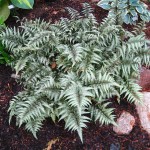Synonymous: Athyrium nipponicum
Asplenium niponicum
Asplenium uropteron
Athyrium uropteron
Athyrium goeringianum
Family: Athyriaceae
Distribution and habitat: Athyrium niponicum occurs in temperate regions in shady places in the lowlands. The species originates from East Asia, primarily Japan, North China, Korea and Taiwan.
Description: Athyrium niponicum is a deciduous herbaceous plant with a weeping habit, being one of the most colourful garden ferns. It is a terrestrial fern with creeping rhizomes and with a whorl of fronds growing from the basal rootstock. The fronds are triangularshaped blades, 25-40cm (10-16 inch) tall and 15-25cm (6-10 inch) broad, pinnate, with 6-10 pairs of pinnae 4-9cm (1.5-3.5 inch) long and 2-3cm (0.8-1.2 inch) broad, deeply lobed. The fronds are bright green with a dark red-brown stem in the wild plant. Fertile fronds form the spore-bearing sori on the underside of all of the pinnae.
This fern has a low and mounding habit, slowly spreading by rhizomes to form dense colonies. The fronds are positioned in a way that creates a horizontal layering effect.
The foliage colors of this fern are more intense in the spring or in cooler temperatures or in cooler climates such as the Northwest. Its colorful foliage should be vibrant from early spring until frost, when it will go dormant and reemerge with its excellent foliage the next spring. Mature fronds hold color and contrast with emerging fronds to form a compact clump.
Gardening: Athyrium niponicum has a medium growth rate, being an easy plant to care for. It will make the garden attraction for spring, summer and fall seasons. Leaves may be trimmed to the ground in late fall or early spring.
It is an trouble-free landscape plant that prefers evenly moist soils, but will tolerate long periods of drought once it is established.
Position: Athyrium niponicum can be grown in sheltered location with partial shade to full shade. To obtain best frond color place these ferns in light shade.
Full sun is tolerated with intensive watering. Leaves color up more with a bit of sun exposure, but their growth will be more vertical and less attractive if they receive too much sun.
Soil: Normal or sandy or clay soils will work well for these ferns. Incorporate lots of well-rotted leaf mould, composted pine needles or garden compost into the planting hole. They will perform well in any rich, evenly moist soil. In cold areas in late autumn protect the crown of the plant with a dry mulch of straw or bracken.
Athyrium niponicum is very cold hardy. It goes dormant in winter by wilting its folds and stopping the new growth of fronds in late fall when temperatures drop to freezing points. Then reemerges with its excellent foliage the next spring.
Water:Good irrigation practices are important. Ferns should be kept moist during active growth period. Water thoroughly the ferns and allow the substrate to dry slightly between waterings. It is best to water early in the day to allow the fronds plenty of time to dry before night time.
Ferns need to be kept consistantly moist at all times. They do not however want to be soggy or water logged.
Fertilising: Athyrium niponicum thrives best when are added 5-8cm (2-3 inch) of compost or peat moss to the beds each spring or fall. This treatment should suffice and no additional fertilising is require.
Adding controlled release fertilizer on the soil surface should be done at low rates, as recommended on label. Ferns are sensitive to high salt levels, so moderation should be considerate when decide to fertilise them.
Propagation: Propagation can be done by spring divisions or by planting spores.
Growth habit and color uniformity is not ensured by spore propagation. Surface sow in a pot of sterile compost in a shady part of the greenhouse and keep moist, this is most easily done by putting the pot in a plastic bag. Pot up small clumps of the plants when they are large enough to handle and keep them moist until they are established. Plant out in late spring of the following year. Division in spring as plants come into growth. Larger divisions can be planted straight into their permanent positions whilst smaller clumps are best potted up and kept in a cold frame until they are growing away well.
Excellent selections ofAthyrium niponicum may also be produced by clump division. Plants are easily divided in spring, every 3 to 4 years. A well-grown plant can be separated in early spring into 3-4 divisions and replanted.
Uses:Athyrium niponicum is grown as an ornamental plant in gardens and suits for containers too. It is wonderful for edging the shade border, in the rock garden or in mixed containers. It is suitable to be used in designing woodland gardens, shade gardens or shaded border fronts. Also effective in shaded areas along streams or ponds. It is one of many ferns suitable for the alpine & rock garden. Succeeds in a semi-shaded bog-garden or in damp woodland, also in garden borders in full or part shade. It can be used as groundcover and mass planting and is good for erosion control.
The fronds work well in cut flower arrangements, providing lasting color and soft texture.
Athyrium niponicum is a good companion of other garden plants with which can share the same environmental conditions and contrast in form and texture such as: Hosta 'Blue Angel' (Hosta), Brunnera macrophylla (Brunnera-Heartleaf), Chasmanthium latifolium (Northern Sea Oats), Cimicifuga ramosa 'Hillside Black Beauty' (Snakeroot-Black), Galium odoratum (Sweet Woodruff), Liriope muscari 'Big Blue' (Lily-turf-Blue), Astilbe 'Rheinland' (Astilbe-Japanese) or Aquilegia 'Cardinal' (Columbine).
Recommended varieties:
Athyrium niponicum var. pictum (Japanese Painted Fern) with pale silvery-green fronds and a bright red stem
Athyrium niponicumvar. pictum 'Red Beauty' with yellow fronds and a bright red stem
Athyrium niponicum 'Metallicum' is noted for its variegated silver, green and red foliage.
Height: 30-60cm (12-23 inch)
Spread: 30-45cm (12-18 inch)
Hardiness zone: 4-9




